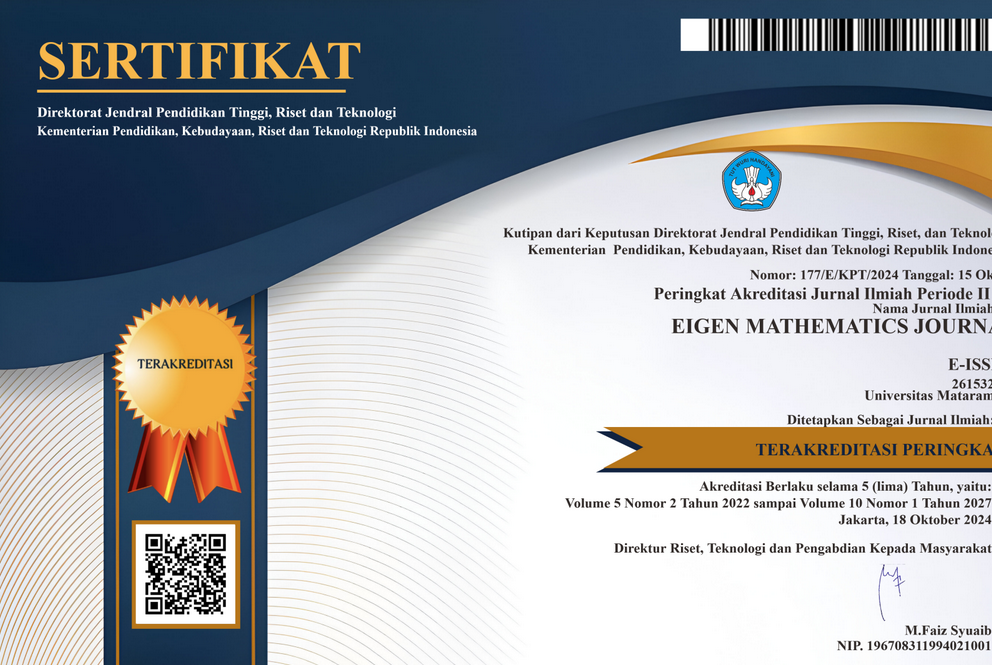Modeling the Open Unemployment Rate in Indonesia Using Panel Data Regression Analysis
DOI:
https://doi.org/10.29303/emj.v7i1.184Keywords:
Regression Analysis, Panel Data, Fixed Effect Model, Open Unemployment Rate, Within GroupAbstract
Indonesia has entered the peak of the demographic bonus which can provide positive and negative impacts for various fields. One of them is in the economic field, namely the increasing number of productive population who are unabsorbed in the world of work and is referred to as an open unemployment. This research was conducted to build a model and to analyze the Open Unemployment Rate, Economic Growth, Provincial Minimum Wage, Level of education, Population growth, Labor Force Participation Rate, Employment, Human Development Index, Poor Residents, Illiterate Population, Average Length of School, Domestic Investment, Foreign Investment, and School Participation Rate, that influence the open unemployment rate in Indonesia using panel data regression analysis with data 2015-2021 from 34 provinces. A fixed effect model with different intercept values for every participant is the best panel data regression model (Fixed Effect Model) that could be found. Based on simultaneously research, it was discovered that every component of the model significantly effect the open unemployment rate. Partially, it was discovered that the following factors significantly effect the open unemployment rate in Indonesia: Employment, Labor Force Participation Rate, Economic Growth, Population Growth, Human Development Index, Poor Population, and Average years of Schooling.References
Astuti, I.Y., Istiyani, N., & Yuliati. (2019). The Effect of Economic Growth, Inflation Rates, and Population Growth on Open Unemployment Rates in Indonesia. Journal of Accounting and Management Economics, 18(1): 52-62.
Baltagi, B. H. (2005). Econometric Analsis of Panel Data 3rd edition. John Wiley & Sons, Ltd. New York.
Center for Social Welfare Research and Development Agency for Education, Research and Social Counseling Ministry of Social RI. (2018). Children of Female Migrant Workers and Demographic Bonus Challenges. Center for Research and Development of Social Welfare Ministry of Social RI, Jakarta.
Directorate of Statistical Dissemination. (2022). Statistics Indonesia 2022. Central Bureau of Statistics, Jakarta.
Directorate of Population and Employment Statistics. (2021). State of the Labor Force in Indonesia August 2021. Central Bureau of Statistics, Jakarta.
Draper, N. R., & Smith, H. (1998). Applied Regression Analysis 3rd edition. John Wiley & Sons, Inc., Canada.
Gujarati, D. N., & Dawn C., Porter. (2009). Basic Econometrics 5th edition. Douglas Reiner, New York.
Khayati, N., & Setyowati, E. (2024). Open Unemploytment Rate in West Java in 2018 to 2021. Proceedings of the International Conference on Economics and Business Studies (ICOEBS-22-2).
Mahendra, K.Y., Susilawati, M., and Suciptawati, N. L. P. (2021). Modeling Open Unemployment Rate in Indonesia, Journal of Mathematics 10(1): pp. 20-25.
Salsabila, R., & Oktora, S. I. (2022). The Impact of Broadband Access on Unemployment Rate in Indonesia 2016-2019. Asian Journal of Business Environment 12(3), 23-30.
Suparman & Muzakir. (2023). Regional Inequality, Human Capital, Unemployment, and Economic Growth in Indonesia: Panel Regression Approach. Cogent Economics & finance 11:2251803.
Yulistiani, R., Putra, N. C., Said, Q., & Ernawati, I. (2020). Classification and Prediction of Open Unemployment Rates in Indonesia Using the Classification and Regression Tree (CART) Method. National Seminar for Computer Science Students and Their Applications (SENAMIKA) 123-130.
Downloads
Published
How to Cite
Issue
Section
License

This work is licensed under a Creative Commons Attribution-NonCommercial-ShareAlike 4.0 International License.
All articles published in the Eigen Mathematics Journal will be available for free reading and downloading. The license applied to this journal is Creative Commons Attribution-Non-Commercial-Share Alike (CC BY-NC-SA).
Similar Articles
- Lisa Harsyiah, Zulhan Widya Baskara, Dina Eka Putri, Rifdah Fadhilah, Analysis of Factors that Influence Poverty in West Nusa Tenggara Using Principal Component Regression , EIGEN MATHEMATICS JOURNAL: Vol. 8 No. 1 (2025): June
You may also start an advanced similarity search for this article.
Most read articles by the same author(s)
- Ni Luh Putu Dewi Wikayanti, Qurratul Aini, Nurul Fitriyani, Pengaruh Kurs Dolar Amerika Serikat, Inflasi, dan Tingkat Suku Bunga Terhadap Indeks Harga Saham Gabungan Dengan Vector Error Correction , EIGEN MATHEMATICS JOURNAL: Vol. 3 No. 1 Juni 2020
- Himayati Himayati, Ni Wayan Switrayni, Desy Komalasari, Nurul Fitriyani, Analisis Rotasi Ortogonal pada Teknik Analisis Faktor Menggunakan Metode Procrustes , EIGEN MATHEMATICS JOURNAL: Vol. 3 No. 1 Juni 2020
- Nirwana Nirwana, Mustika Hadijati, Nurul Fitriyani, Estimasi Parameter Model Moving Average Orde 1 Menggunakan Metode Momen dan Maximum Likelihood , EIGEN MATHEMATICS JOURNAL: Vol. 1 No. 1: Juni 2018
- Moudy Puspita Ayudhiah, Syamsul Bahri, Nurul Fitriyani, Peramalan Indeks Harga Konsumen Kota Mataram Menggunakan Vector Autoregressive Integrated Moving Average , EIGEN MATHEMATICS JOURNAL: Vol. 3 No. 1 Juni 2020
- Jusmawati Jusmawati, Mustika Hadijati, Nurul Fitriyani, Penerapan Model Vector Autoregressive Integrate Moving Average dalam Peramalan Laju Inflasi dan Suku Bunga di Indonesia , EIGEN MATHEMATICS JOURNAL: VOL. 3 NO. 2 DESEMBER 2020
- Rifdah Fadhilah, Lisa Harsyiah, Nuzla Af’idatur Robbaniyyah, The Decision on Selecting the Best Laptop Using Analytical Hierarchy Process and Simple Additive Weighting Method at the Faculty of MIPA University of Mataram , EIGEN MATHEMATICS JOURNAL: Vol. 7 No. 2 (2024): December
- Ulfa Destiarina, Mustika Hadijati, Desy Komalasari, Nurul Fitriyani, Estimasi Parameter Distribusi Mixture Eksponensial dan Weibull dengan Metode Bayesian Markov Chain Monte Carlo , EIGEN MATHEMATICS JOURNAL: Vol. 2 No. 1 Juni 2019
- Lailatul Pahmi, Emmy Dyah Sulistiowati, Lisa Harsyiah, Analysis of Bottled Water Quality Control Using the FMEA Method and the Application of Kaizen (Case Study at PT. Lombok Pusaka Adam, Jelantik, Central Lombok) , EIGEN MATHEMATICS JOURNAL: Vol. 5 No. 1 Juni 2022
- Deni Pratiwi, Lalu Abd Azis Mursy, Muhammad Rizaldi, Nurul Fitriyani, Regresi Nonparametrik Kernel Gaussian pada Pemodelan Angka Kelahiran Kasar di Provinsi Nusa Tenggara Barat , EIGEN MATHEMATICS JOURNAL: VOL. 3 NO. 2 DESEMBER 2020
- Bidayani Bidayani, Mustika Hadijati, Nurul Fitriyani, Model Regresi Semiparametrik Spline Hasil Produksi Padi di Kabupaten Lombok Timur , EIGEN MATHEMATICS JOURNAL: Vol. 2 No. 1 Juni 2019






